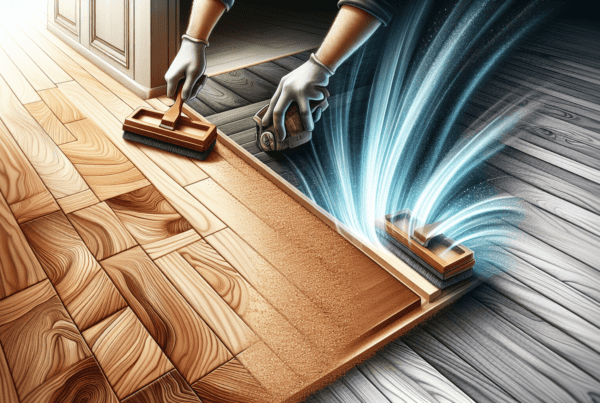In this article, let’s explore the world of Wellington’s Professional Timber Floor Sanding & Finishing, where elegance meets craftsmanship. Based in the heart of Wellington, this exceptional service transforms the ordinary into the extraordinary by breathing new life into tired wood floors. With a keen eye for detail and a passion for perfection, their team ensures that every plank and panel receives the care it deserves, emerging as a polished testament to beauty and durability. Join us as we uncover the artistry and precision behind Wellington’s most sought-after floor refinishing service.
Overview of Timber Floor Sanding & Finishing Services in Wellington
Importance of professional timber flooring services
For those of us residing in Wellington, the importance of professional timber flooring services cannot be overstated. Timber floors add an unmatched beauty and warmth to our homes, but they do require regular maintenance to keep them looking their best. Professional services, such as sanding and finishing, not only revive the look of our timber floors but also protect them from wear and tear. It’s more than just upkeep; it’s about ensuring your floors remain a valuable feature of your home for years to come.
The benefits of sanding and finishing for timber floors
Sanding and finishing bring out the best in our timber floors. Sanding removes the top layer, getting rid of scratches, dents, and unevenness. Finishing, on the other hand, involves applying a protective coating that enhances the floor’s durability. Together, these processes restore the natural beauty of the wood, improve its lifespan, and make it easier to clean and maintain.
Overview of Wellington’s market for timber floor services
Wellington’s market for timber floor sanding and finishing services is robust, with skilled professionals offering a range of options tailored to our different needs and preferences. From historic homes in need of delicate restoration to modern apartments seeking a contemporary finish, there’s a service provider for every scenario. This healthy competition ensures high standards across the board, which is great news for us, the homeowners.
Understanding Timber Floors
Types of timber floors popular in Wellington
Wellington homes feature a variety of timber floors, from classic native woods like Rimu and Kauri to popular international hardwoods such as Oak and Maple. Each type offers a distinct look and feel, making timber floors a versatile choice for different decorative styles and practical needs.
The natural characteristics of timber flooring
What sets timber flooring apart is its natural characteristics – the grain patterns, the color variations, and the warmth underfoot. These qualities can transform a mere building into a home, introducing a sense of nature and authenticity to our living spaces.
Why timber floors require regular maintenance
Timber, being a natural material, reacts to its environment. It expands and contracts with changes in humidity and can show wear over time from foot traffic or spills. This makes regular maintenance, like sanding and finishing, crucial not just for aesthetics but also to protect the wood and extend its life.
The Process of Timber Floor Sanding
Initial assessment and preparation
Before the sanding process begins, a thorough assessment of the timber floor is necessary. We need to identify any damage, like deep scratches or warped boards, and decide on the appropriate level of sanding required. Preparation also involves removing furniture, ensuring the space is well-ventilated, and protecting any fixed features in the room.
Detailed description of the sanding process
The sanding process involves three main stages – coarse, medium, and fine sanding. Starting with coarse-grit sandpaper removes the old finish and any major imperfections. Subsequent passes with finer grits smooth out the surface, preparing it for finishing. It’s a meticulous process that transforms the floor step by step.
Equipment and tools used in timber floor sanding
Professional floor sanders use a variety of tools, including belt sanders, edge sanders, and orbital sanders. These machines are designed to efficiently remove the old finish and smooth out the surface without damaging the timber underneath. Dust extraction systems are also crucial to keep the workspace clean and the air quality safe.
Finishing Techniques for Timber Floors
Types of finishes available for timber floors
When it comes to finishes, we have options ranging from polyurethane coatings, which offer a high level of protection and gloss, to oil-based finishes that enhance the natural look of the wood. Water-based finishes are also popular for their quick drying times and lower environmental impact.
Steps involved in applying finish to timber floors
After sanding, the floor must be thoroughly cleaned to remove all dust. The chosen finish is then applied evenly across the floor, often in multiple coats, allowing ample drying time between each. The specific method of application can vary depending on the type of finish – some might be brushed on, while others might be rolled or sprayed.
Choosing the right finish for your timber floor
Selecting the right finish depends on several factors including the type of timber, the level of foot traffic, and the desired aesthetic. We must weigh the pros and cons of each finish type to decide which one aligns best with our needs and preferences.
Benefits of Professional Sanding & Finishing
Enhancing the durability of timber floors
A professionally sanded and finished timber floor is far more durable than an untreated one. The protective layer added during finishing defends the wood against spills, stains, and physical wear, extending the floor’s lifespan and saving us future repair costs.
Improving the aesthetic appeal of floors
There’s no denying the aesthetic transformation that sanding and finishing can bring to our timber floors. The processes accentuate the wood’s natural beauty, making our floors a striking feature of our homes once again.
Preventing long-term damage and repair costs
Regular sanding and finishing not only keep our floors looking beautiful but also prevent long-term damage such as deep scratches, discoloration, and structural wear. This proactive maintenance saves us potentially hefty repair costs down the line.
Choosing the Right Service Provider in Wellington
What to look for in a timber floor service provider
When selecting a service provider in Wellington, we should consider their experience, expertise, and the quality of their past work. A reliable provider will offer transparent quotes, a clear timeline, and guidance on the best care for our floors post-service.
Comparing quotes and services offered
It’s wise to compare quotes and services from multiple providers. This doesn’t just help us find a competitive rate; it also gives us a sense of the market standard and what we should expect for our investment.
Checking reviews and past work portfolios
Reviews and past work portfolios are invaluable in assessing a provider’s reliability and quality of work. Positive feedback from previous clients and a portfolio of beautifully finished floors are strong indicators of a service provider worth considering.
Cost Considerations for Sanding & Finishing
Factors affecting the cost of timber floor services
The cost of timber floor services can vary widely, influenced by the floor’s size, the type of timber, the condition of the floor, and the chosen finish. It’s important for us to understand these factors as they will impact the overall cost of the project.
How to budget for sanding and finishing projects
We should get quotes from several providers to gauge the average cost for our specific needs. This, alongside a clear understanding of the factors affecting price, will help us set a realistic budget for our sanding and finishing project.
Ways to save money without compromising quality
To save money without compromising on quality, we could consider doing some preparatory work ourselves, like removing furniture or choosing a less expensive but still durable finish. It’s also worth asking providers about any deals or off-peak discounts they might offer.
Maintenance Tips After Sanding & Finishing
Regular cleaning and care tips
After our floors have been sanded and finished, regular cleaning with a soft broom or microfiber mop helps keep them looking their best. We should avoid harsh chemicals or excessive water, which can damage the finish.
When to schedule professional maintenance
Even with diligent care, timber floors will eventually need professional maintenance. We should keep an eye out for signs of wear or dullness and consider scheduling a professional refinish every few years, depending on foot traffic and wear.
Dealing with scratches and marks on finished floors
Minor scratches and marks can often be addressed with spot repairs using a matching wood putty or a touch-up kit designed for our specific finish. For more significant damage, consulting a professional may be necessary.
Common Mistakes to Avoid
Attempting DIY sanding without proper equipment
DIY sanding without the right equipment or experience can lead to uneven surfaces, damage to the timber, and a lot of frustration. It’s usually best to leave this task to the professionals.
Neglecting the importance of professional finishing
Skipping professional finishing after sanding is like leaving a job half done. The finish protects the wood and brings out its natural beauty, making it an essential part of the process.
Failing to consider the long-term care of timber floors
Timber floors are a significant investment, and their care shouldn’t end with sanding and finishing. Regular maintenance and prompt attention to any damage are key to ensuring our floors last a lifetime.
FAQs on Timber Floor Sanding & Finishing in Wellington
How often should timber floors be sanded and finished?
The frequency depends on the floor’s usage and wear, but generally, timber floors should be sanded and finished every 7-10 years.
Can all types of timber floors be sanded and refinished?
Most timber floors can be sanded and refinished, but there are exceptions, especially with very thin or significantly damaged floors. It’s best to consult a professional.
What is the turnaround time for professional sanding and finishing?
The timeline can vary depending on the floor’s size and condition, but most projects in Wellington are completed within a few days to a week.







